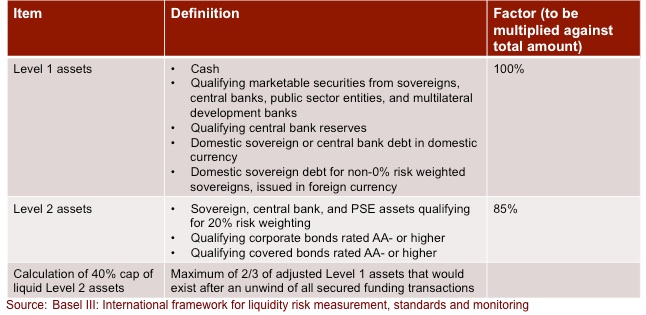Banks everywhere are focusing on the Liquidity Coverage Ratio (LCR) provisions in Basel III. The provisions don’t kick in until 2015, but the observation period is in full swing and no one wants to tell their management that they missed the target. The epicenter of the ratio at many institutions is the repo business. They can best manage the measurement and control the flows. And, it wouldn’t be the finance sector if a number of tricks innovations hadn’t emerged to soften the blow.
The LCR requires banks to hold High Quality Liquid Assets (HQLA). From the BIS, “[The Liquidity Coverage Ratio] standard aims to ensure that a bank maintains an adequate level of unencumbered, high-quality liquid assets that can be converted into cash to meet its liquidity needs for a 30 calendar day time horizon under a significantly severe liquidity stress scenario specified by supervisors. At a minimum, the stock of liquid assets should enable the bank to survive until Day 30 of the stress scenario, by which time it is assumed that appropriate corrective actions can be taken by management and/or supervisors, and/or the bank can be resolved in an orderly way. “
From Finadium’s April 2012 report, “Corporate Bonds and Equities as High Quality Assets for Collateral Management and Bank Balance Sheets” (a synopsis is here) is the following table outlining the eligible assets:
The widening out of what will be eligible as HQLA as well as softening the haircuts is a hot topic. The global shortages of “safe assets” will stress the system. We wrote about that in our April 12, 2012 post, where we quoted the IMF as saying that the LCR requirements could absorb $2 – $4 trillion on assets. This is pressuring the regulators to qualify a broader array of paper under HQLA and the banks are leading the lobbying effort.
A handful of banks have marketed evergreen repo structures. Banks take in HQLA for, say, 60 days. The trades are automatically extended (all else being equal) when the maturity of the trades approach 31 days. The bank can say they have assets on the books for at least the 30 days mandated by LCR. As a structured term trade that locks up the use of the collateral, the rates are more attractive to the securities holder.
One source of collateral that will surely be tapped are the securities lenders. Some are saying this will usher in a new golden era of demand for assets sitting with custodians – a business that has been basically moribund since the demise of Lehman and implementation of zero rates. But who will actually do the trades? Will the beneficial owners take the bait and commit to lock up their collateral for term (and how will they manage the cash reinvest)? Or will the custodians take the maturity transformation risk and trade directly with the repo desks, tapping their client’s bonds for liquid assets? If the latter, then custodians better have a good idea of how much of the HQLA they hold for their clients are permanent. This kind of business can be appropriate risk managed, but it will be tricky. In a May 29, 2012 article by Sophie Baker in Financial News (sorry…behind the pay wall) David Lewis of SunGard was quoted, “[Custodians] would only be engaged based on the likelihood of the pool of assets being sufficient. However, they would have to make sure there is enough left in the pool to cover any sales, so that squeezes supply and limits the assets that can be put out to market.”
What will be harder is sidestepping the criticism that the securities lenders are enabling the kind of maturity transformation and non-backstopped shadow banking business that others, especially ETF funds, have been recently savaged for. A FRB New York research report “Shadow Banking” (July, 2010, revised February, 2012), said, “… there exist a wide range of credit intermediation activities which take place without official credit enhancements…the securities lending activities of insurance companies, pension funds and certain asset managers do not benefit from access to official liquidity…” Perhaps even more damning was Paul Tucker’s April 27, 2012 speech on shadow banking where he said “…anyone holding a securities portfolio can build themselves a shadow bank using the securities lending and repo markets…. One simply lends out the securities at call for cash, and then one employs that cash by making loans or buying credit-assets with a longer maturity. This is leverage and maturity mismatch.”
Securities lending programs supporting maturity transformation programs, especially those set up to avoid the LCR, will run the risk of a wrist slap from regulators and potential bad press. While individual lenders and agents will make money in the short term, these kinds of trades as a group are part of what the Fed and Mr. Tucker are targeting in their comments. Securities lenders should be cautioned that they are making themselves into a potential target with these term trades.
A link to the BIS paper is here
A link to the Fed research report is here.
A link to Paul Tucker’s speech is here.


